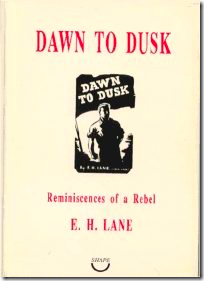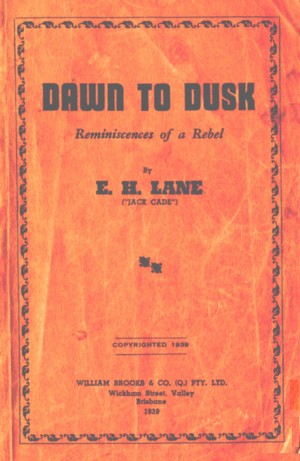 The May meeting of the 17 Group will be on Wednesday the 4th of May at 7pm in unit 6 at 20 Drury St, West End. As you probably know, after the failure of the great strikes of the early 1890s the labour movement in Australia was in crisis. One response was the formation of the ALP. But another and apparently more radical one was the formation of the New Australia Movement, in which a despondent William Lane was to lead a group of disappointed radicals in setting up a utopian socialist community in Paraguay. Mark Cryle will be talking about several important aspects of this social experiment, survivors of which still exist in Paraguay to this day.
The May meeting of the 17 Group will be on Wednesday the 4th of May at 7pm in unit 6 at 20 Drury St, West End. As you probably know, after the failure of the great strikes of the early 1890s the labour movement in Australia was in crisis. One response was the formation of the ALP. But another and apparently more radical one was the formation of the New Australia Movement, in which a despondent William Lane was to lead a group of disappointed radicals in setting up a utopian socialist community in Paraguay. Mark Cryle will be talking about several important aspects of this social experiment, survivors of which still exist in Paraguay to this day.
Here is Marks summary of the themes of his talk:
Race politics and reading practices: two aspects of the New Australia experiment.
In July 1893 a group of colonists, led by William Lane, sailed from Sydney to establish a socialist cooperative settlement in Paraguay. In arguably Australia’s best known diaspora, approximately 500 Australians ventured to two settlements, New Australia and Cosme over the next ten years. Some stayed only a few days. The descendants of others still live there. Mark will give an account of that venture focussing on two particular aspects the colonists racial attitudes and their library collection.
The constitution of Lanes New Australia Co-operative Settlement Association articulated that membership was denied to any person of colour, including any married to persons of colour. Lanes colonists pledged to observe this colour line. It is one expression of an international assertion of white pre-eminence and a preoccupation with white racial exclusivity evident from the mid 1880s. It is ironic that this particular crest in what has been labelled a tidal wave of whiteness, (Lake & Reynolds, Drawing the global colour line, 2008, p.2) should have swelled in Paraguay, a country whose own demographic reflected a markedly-contrasting tradition of racial hybridity.
Some years after its establishment, the Cosme settlement reported the presence of a library on their commune, in a very creditable condition, being well stocked, used and looked after. What were its origins? Which texts occupied its shelves and what role did it play in the lives of these incorrigible determined readers (Scates, A New Australia, 1997, p.45) whose venture was, to a significant degree, the culmination of the nineteenth century radical dream? In tracing its history we gain insights into radical reading practices of the age. Their library was an institution of which the colonists were justly proud and on which they report in some detail. Its growth and demise reflect the fortunes of the colony itself.
Short biography of Mark:
Until very recently Mark Cryle was the Manager of the Fryer Library at the University of Queensland. Fryer is UQ’s special collection of Australiana and rare books. Mark has just enrolled in a PhD examining the way that Anzac Day has been interpreted in prose, poetry and drama. Mark has published research on Queensland’s Indigenous past and other aspects of Queensland’s history. He is a member of the Queensland Working Party of the Australian Dictionary of Biography. He is also a musician and songwriter.
Trotsky, on a faulty line, (no joke intended), is reported to have heard in Paraguay instead of about Paraguay when his accredited Brisbane representative tried by phone to get him to come over for our discussion, and he immediately headed south from Mexico City to be at the meeting early, so, if doubtful points arise, we can try to get him on the very spot on his mobile. But dont rely on your mobile. Be there!

— Green Left Weekly 17 Aug 2011
Reference – Catalogue of Books worth reading (found in Dawn to Dusk)
Hello,
I have been searching the net for articles about the New Australia community in Paraguay and found your site.
My ex-husband is a grandson of Tom Hall who was the secretary of the Shearer’s Union during the Great Shearer’s Strike. Tom also travelled to Paraguay to join Lane in his new colony. Tom married a local woman and had children (4 I think) and they still live there today. After his wife died and the children were grown up, Tom travelled back to England and then back to Australia where he settled in south-west Western Australia at Kendenup and farmed there and raised another family, whose descendants are in the Mt Barker area today.
It is a fascinating story about the New Australia in Paraguay. We had some very interesting, adventurous people in Australia in the early days who did spectacular things or at least tried to.
Thank you for your continued interest in this part of Australia’s history.
Mary Hall
[caption id="" align="alignleft" width="83" caption="Click to read"] [/caption]
[/caption]
I am sorry I could not attend this talk.
So with only the notes above to refer to, I dispute the characterisation of Cosme being a racist colony. Perhaps Mark Cryle did not intend that. However the notes do suggest this when they state:
Such a characterisation is too simplistic.
Ernie Lane who joined his brother, William, in Paraguay opposed the White Australian policy put forward by the jingoes in the Australian Workers Union and the ALP.
In 1903 Ernie Lane with his wife and three children went to Cosme, the breakaway colony from New Australia in Paraguay, but left it in 1904 in disgust at its drift from communistic principles. So there was division within the community and this issue may have been one of them. Perhaps Mark explains that in his talk.
Clarrie Beckingham, who published ‘Dawn to Dusk’ – the memoirs of Ernie Lane in 1939, if he were alive today, would have disputed that Ernie & Mabel Lane had anything to do with racist ideology. They were avowed anti-racists at a time when jingoism was rife in sections of the union movement (AWU) and in parts of the ALP (Billie Hughes). Ithink that Clarrie married Ernie & Mabel’s daughter, Alice, who was born in the Argentine.
Dawn-to-Dusk- edition by Social History of Australia Project (LeftPress).]
See also The Lanes of Cosme Colona, Paraguay, 1893-1904 / [[compiled] by Clarrie Beckingham